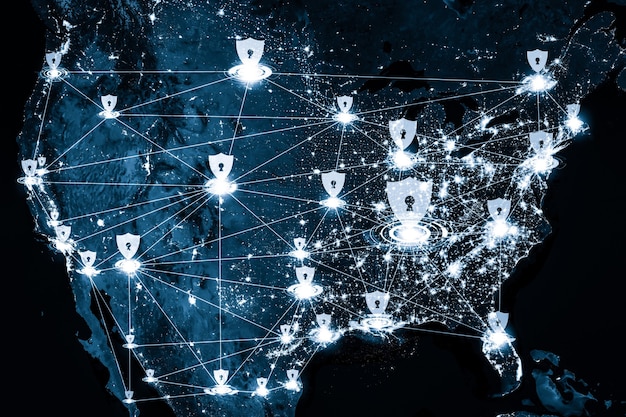US Cybersecurity Strategy: Protecting American Interests in the Digital Age

The US Cybersecurity Strategy addresses the growing threats in cyberspace by focusing on protecting critical infrastructure, combating malicious cyber actors, and promoting a secure and resilient digital ecosystem to safeguard American interests.
In an increasingly interconnected world, the US Cybersecurity Strategy: Protecting American Interests in an Increasingly Digital World has become paramount. This strategy outlines the comprehensive approach the United States is taking to secure its digital assets, infrastructure, and information against a growing array of cyber threats.
Understanding the Core Pillars of the US Cybersecurity Strategy
The US Cybersecurity Strategy is built upon several key pillars which outline the main objectives and approaches. These pillars are designed to work together, creating a multi-faceted defense against cyber threats. Understanding these pillars is critical to grasping the overall strategy.
Protecting Critical Infrastructure
One of the primary pillars of the US Cybersecurity Strategy is the protection of critical infrastructure. This includes sectors such as energy, finance, healthcare, and communications, which are essential for the functioning of the nation.
Combating Cybercrime and Malicious Actors
Another essential pillar focuses on combating cybercrime and malicious actors. This involves identifying, disrupting, and prosecuting individuals and groups engaged in cyber activities that threaten US interests.
- Enhancing law enforcement capabilities to investigate and prosecute cybercrimes.
- Strengthening international cooperation to combat cyber threats and share information.
- Implementing measures to deter malicious cyber activities through sanctions and other means.
In conclusion, the core pillars of the US Cybersecurity Strategy reflect a comprehensive approach to protecting American interests in the digital age, addressing both defensive and offensive measures.

Addressing Key Challenges in Cybersecurity
The US Cybersecurity Strategy faces several key challenges that must be addressed to ensure its effectiveness. These challenges range from technological advancements to geopolitical tensions, requiring innovative solutions and adaptability.
Evolving Technological Landscape
The rapid pace of technological advancements presents a significant challenge for cybersecurity. New technologies such as artificial intelligence (AI), blockchain, and the Internet of Things (IoT) introduce new vulnerabilities that must be addressed.
Geopolitical Tensions and State-Sponsored Threats
Geopolitical tensions and state-sponsored cyber activities pose a constant threat to US cybersecurity. Nation-states often engage in cyber espionage, sabotage, and influence operations to advance their strategic interests.
- Strengthening diplomatic efforts to establish norms of behavior in cyberspace.
- Developing capabilities to deter and respond to state-sponsored cyberattacks.
- Enhancing intelligence gathering and analysis to identify and attribute malicious cyber activities.
In summary, addressing these key challenges requires collaboration across government, industry, and academia to develop and implement effective cybersecurity solutions.
The Role of Public-Private Partnerships
Public-private partnerships are a cornerstone of the US Cybersecurity Strategy which recognizes that government and private sector collaboration is essential for securing cyberspace. These partnerships leverage the unique strengths and resources of both sectors to enhance cybersecurity capabilities.
Information Sharing and Collaboration
One of the primary benefits of public-private partnerships is the ability to share information about cyber threats and vulnerabilities. This enables organizations to better understand and respond to emerging risks.
Enhancing Cybersecurity Standards and Best Practices
Public-private partnerships also play a crucial role in developing and implementing cybersecurity standards and best practices. By working together, government and industry can create frameworks that enhance cybersecurity across various sectors.
- Establishing joint task forces to address specific cyber threats and incidents.
- Conducting joint training exercises and simulations to improve incident response capabilities.
- Developing and promoting cybersecurity standards and best practices through industry associations and government agencies.
Ultimately, the success of the US Cybersecurity Strategy depends on the strength and effectiveness of public-private partnerships.

The Impact on American Businesses and Consumers
The US Cybersecurity Strategy has a direct impact on American businesses and consumers, shaping how organizations approach cybersecurity and influencing the protection of personal data. The effectiveness of this strategy is crucial for maintaining trust and confidence in the digital economy.
Compliance and Regulatory Requirements
Businesses must comply with various cybersecurity regulations and standards to protect sensitive data and maintain operational resilience. The strategy emphasizes the importance of adhering to these requirements to mitigate cyber risks.
Protecting Consumer Data and Privacy
Protecting consumer data and privacy is a key objective of the US Cybersecurity Strategy. Consumers need to have confidence that their personal information is secure and that organizations are taking appropriate measures to protect it.
- Implementing stronger data protection measures, such as encryption and access controls.
- Providing consumers with greater control over their personal data and how it is used.
- Enhancing consumer education and awareness about cybersecurity risks and best practices.
In conclusion, the US Cybersecurity Strategy aims to create a secure and resilient digital ecosystem that protects the interests of both businesses and consumers.
Future Directions and Emerging Trends
The future of the US Cybersecurity Strategy will be shaped by emerging trends and evolving threats. Adapting to these changes will be crucial for maintaining a strong cybersecurity posture and protecting American interests.
Adopting Zero Trust Architectures
Zero trust is a security framework based on the principle of “never trust, always verify.” It assumes that threats can come from both inside and outside the organization, requiring continuous authentication and authorization for all users and devices.
Leveraging Artificial Intelligence and Machine Learning
AI and machine learning technologies are being increasingly used to enhance cybersecurity capabilities. These technologies can automate threat detection, incident response, and vulnerability management, improving efficiency and effectiveness.
- Developing AI-powered threat detection systems that can identify and respond to malicious activities in real-time.
- Using machine learning algorithms to analyze large datasets and identify patterns of cyberattacks.
- Implementing AI-based security tools to automate vulnerability assessments and patch management.
To summarize, the future of the US Cybersecurity Strategy depends on the ability to adapt to emerging trends and leverage new technologies to enhance cybersecurity capabilities.
International Cooperation and Alliances
International cooperation and alliances are essential components of the US Cybersecurity Strategy. Cyber threats often transcend national borders, requiring coordinated efforts to address them effectively. Collaborating with allies and partners enhances the ability to deter and respond to cyberattacks.
Sharing Threat Intelligence and Best Practices
One of the primary benefits of international cooperation is the sharing of threat intelligence and best practices. This enables countries to better understand and respond to emerging cyber threats and vulnerabilities.
Joint Exercises and Training Programs
Joint exercises and training programs are another important aspect of international cooperation. These activities improve incident response capabilities and enhance coordination among participating countries.
- Establishing formal agreements and partnerships with key allies to enhance cybersecurity cooperation.
- Participating in international forums and initiatives to promote norms of behavior in cyberspace.
- Conducting joint cyber exercises and training programs to improve incident response capabilities.
In short, international cooperation and alliances are critical for enhancing global cybersecurity and protecting American interests in an increasingly interconnected world.
| Key Aspect | Brief Description |
|---|---|
| 🛡️ Critical Infrastructure | Protecting essential sectors like energy, finance, and healthcare from cyber threats. |
| 🤝 Public-Private Partnerships | Collaboration between government and private sectors to share information and enhance security. |
| 🌐 International Cooperation | Working with allies to address cyber threats that transcend national borders. |
| 🤖 AI and Machine Learning | Using AI and ML to automate threat detection and improve incident response. |
Frequently Asked Questions
▼
The primary goal is to protect American interests in cyberspace by securing critical infrastructure, combating cybercrime, and promoting a resilient digital ecosystem. This ensures national security and economic stability.
▼
The strategy enhances intelligence gathering, strengthens diplomatic efforts, and develops capabilities to deter and respond to state-sponsored cyberattacks. Sanctions and other measures are used to dissuade malicious activities.
▼
These partnerships facilitate information sharing, enhance security standards, and improve incident response. Collaboration leverages the strengths of both sectors to create a more robust defense against cyber threats.
▼
AI is used to automate threat detection, analyze large datasets for patterns of cyberattacks, and improve vulnerability assessments. It enhances the efficiency and effectiveness of cybersecurity measures.
▼
International cooperation enables the sharing of threat intelligence, promotes norms of behavior in cyberspace, and enhances coordination among countries. Joint exercises improve incident response capabilities globally.
Conclusion
In conclusion, the US Cybersecurity Strategy is a comprehensive framework designed to protect American interests in an increasingly digital world. By focusing on key pillars, addressing critical challenges, and fostering collaboration, the strategy seeks to ensure a secure and resilient cyber ecosystem for businesses, consumers, and the nation as a whole.





